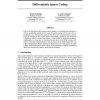Free Online Productivity Tools
i2Speak
i2Symbol
i2OCR
iTex2Img
iWeb2Print
iWeb2Shot
i2Type
iPdf2Split
iPdf2Merge
i2Bopomofo
i2Arabic
i2Style
i2Image
i2PDF
iLatex2Rtf
Sci2ools
NIPS
2008
2008
Differentiable Sparse Coding
Prior work has shown that features which appear to be biologically plausible as well as empirically useful can be found by sparse coding with a prior such as a laplacian (L1) that promotes sparsity. We show how smoother priors can preserve the benefits of these sparse priors while adding stability to the Maximum A-Posteriori (MAP) estimate that makes it more useful for prediction problems. Additionally, we show how to calculate the derivative of the MAP estimate efficiently with implicit differentiation. One prior that can be differentiated this way is KL-regularization. We demonstrate its effectiveness on a wide variety of applications, and find that online optimization of the parameters of the KL-regularized model can significantly improve prediction performance.
| Added | 30 Oct 2010 |
| Updated | 30 Oct 2010 |
| Type | Conference |
| Year | 2008 |
| Where | NIPS |
| Authors | J. Andrew Bagnell, David M. Bradley |
Comments (0)

